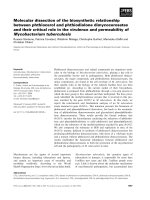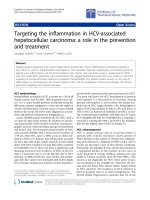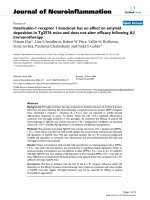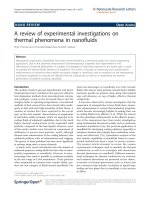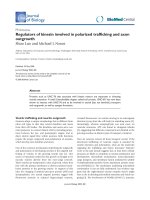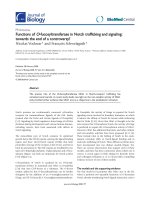Investigations on rab31s role in EGFR trafficking and neural progenitor cell differentiation towards astroglia
Bạn đang xem bản rút gọn của tài liệu. Xem và tải ngay bản đầy đủ của tài liệu tại đây (20.38 MB, 186 trang )
INVESTIGATIONS ON RAB31’S ROLE IN
EGFR TRAFFICKING AND NEURAL PROGENITOR
CELL DIFFERENTIATION TOWARDS ASTROGLIA
CHRISTELLE CHUA EN LIN
B. Sc (Hons.), NUS
A THESIS SUBMITTED FOR
THE DEGREE OF DOCTOR OF PHILOSOPHY
NUS GRADUATE SCHOOL FOR INTEGRATIVE
SCIENCES AND ENGINEERING
NATIONAL UNIVERSITY OF SINGAPORE
2014
Declaration
I hereby declare that this thesis is my original work and it has been written by me in
its entirety. I have duly acknowledged the sources of information which have been
used in the thesis.
This thesis has also not been submitted for any degree in the university previously.
_____________________
Christelle Chua En Lin
11 April 2014
i
Acknowledgements
I would like to thank my supervisor, A/Prof Tang Bor Luen, for his unwavering
support and mentorship through the course of my studies.
I would also like to acknowledge our past and present lab members, for their expertise
and assistance which have contributed to my research.
Lastly, I would like to extend my gratitude to my family and friends for their support
and encouragement.
ii
Table of Contents
Summary v
List of Tables vii
List of Figures vii
List of Symbols xi
List of Abbreviations xii
1. Introduction 1
1.1 Overview of Rab GTPases 1
1.1.1 Rab-interacting proteins and how they aid in achieving specificity in Rab
function 4
1.1.2 Localisation of Rab proteins to target membranes 8
1.1.3 Rab cascades and crosstalk between Rabs and their interacting proteins 15
1.2 Overview of the Rab5 subfamily 18
1.2.1 The endocytic system intersects with cellular signalling 18
1.2.2 Rab5 subfamily members and the EGFR trafficking pathway 20
1.2.3 Other Rabs implicated in the EGFR trafficking pathway 25
1.2.4 Introduction to Rab31 25
1.3 Physiological and pathophysiological activities of Rabs 29
1.3.1 Role of Rabs in cancer 30
1.3.2 Role of Rabs in the nervous system 31
1.4 Rationale for studies reported in this thesis 34
2. Materials and Methods 36
2.1 Gene constructs 36
2.2 Antibodies 37
2.3 Cell culture and transfection 38
2.4 Primary mouse neural progenitor cell (NPC) culture 38
iii
2.5 Expression silencing 39
2.6 Retroviral transduction 40
2.7 Reverse-transcription and real-time PCR 41
2.8 EGF pulse-chase experiments 42
2.9 Collection of cell lysate and Western blot 43
2.10 Immunocytochemistry, immunohistochemistry, and immunofluorescence
microscopy 43
2.11 Live-cell imaging 44
2.12 Flow cytometry 44
2.13 Glycerol gradient sedimentation 44
2.14 Co-immunoprecipitation 45
2.15 GST affinity pulldown assay 45
2.16 Statistical analysis 45
3. Domains and interactions responsible for the subcellular localisation of Rab31 46
3.1 Chapter Introduction: Localisation of Rab proteins to distinct membranes 46
3.2 Results: Dependence of Rab31 subcellular localisation on functional domains 47
3.3 Results: Dependence of Rab31 subcellular localisation on interacting proteins 51
3.4 Chapter Discussion: Factors influencing Rab31 subcellular localisation 57
4. Role of Rab31 in EGFR trafficking 61
4.1 Chapter Introduction: Rab proteins in trafficking of cell surface receptor EGFR 61
4.2 Results: Rab31 in endocytosis and degradation of EGFR 62
4.3 Results: Rab31 in recycling of EGFR 85
4.4 Chapter Discussion: Rab31 plays a role in early-to-late endosome trafficking of
ligand-bound EGFR through a trafficking complex 87
5. The role of Rab31-interacting proteins in Rab31-mediated EGFR trafficking 89
5.1 Chapter Introduction: Potential Rab31-interacting proteins in an EGFR-
trafficking complex 89
iv
5.2 Results: Role of EEA1 in Rab31-mediated EGFR trafficking 90
5.3 Results: Role of GAPex5 in Rab31-mediated EGFR trafficking 97
5.4 Results: RIN3 mediates a separate trafficking role of Rab31 102
5.5 Chapter Discussion: Interacting proteins mediate different roles of Rab31 107
6. Physiological role of Rab31 in the central nervous system 110
6.1 Chapter Introduction: Astrocytic cells and neurogenesis in the brain 110
6.2 Results: Rab31 in the adult rodent brain 112
6.3 Results: Rab31 in neural progenitor cells 117
6.4 Chapter Discussion: Possible role of Rab31 in NPCs and astrocytes 135
7. Conclusion and future perspectives 139
7.1 General conclusions 139
7.2 Applications and implications of our findings 144
References 150
Appendix 1 – Plasmid vectors 165
Appendix 2 – List of Publications 168
v
Summary
Rab31 is a member of the Rab5 subfamily of Rab GTPases, which play a role in
trafficking of endocytic lumenal and membrane cargo. We have investigated factors
influencing Rab31’s subcellular localisation and found that Rab31 functional domains
and interacting partners are both important to its localisation at the trans-Golgi
network (TGN). We also investigated Rab31’s role in the trafficking of ligand-bound
epidermal growth factor (EGF) receptor (EGFR) internalised through receptor-
mediated endocytosis, which has hitherto not been explored. We found that depletion
of Rab31 inhibits, while Rab31 overexpression enhances, EGFR trafficking to the late
endosomes. Rab31 was found to interact with EGFR by co-immunoprecipitation and
affinity pulldown analyses, and the primarily TGN-localised Rab31 has increased
colocalisation with EGFR on endosomes at 30 min after pulsing with EGF. We found
that loss of early endosome antigen 1 (EEA1), a Rab31 effector, reduced the
interaction between Rab31 and EGFR, and abrogated the effect of Rab31
overexpression on the trafficking of EGFR. Likewise, loss of GAPex5, a Rab31
guanine nucleotide exchange factor (GEF) that has a role in ubiquitination and
degradation of EGFR, reduced the interaction of Rab31 with EGFR and its effect on
EGFR trafficking. Taken together, our results suggest that Rab31 is an important
regulator of endocytic trafficking of EGFR, and functions in an EGFR trafficking
complex that requires EEA1 and GAPex5 for its formation. To explore the
physiological role of Rab31 which is highly expressed in radial glia and mature
astrocytes, we looked at Rab31 in neural progenitor cells (NPCs) both in the
neurogenic regions of the adult mouse brain and in culture. NPCs expressed high
levels of Rab31, but when NPCs were induced to differentiate, Rab31 levels dipped
then reappeared in a subset of the glial fibrillary acidic protein (GFAP)-positive
vi
astrocyte population. Depletion of Rab31 appeared to decrease the percentage of
GFAP-positive cells obtained. This suggests that Rab31 plays a role in the
differentiation of neural progenitor cells of the brain. This may be, in part, due to its
role in EGFR trafficking. Results presented in this thesis have implications for both
our understanding of neurogenesis and cancer therapeutics.
vii
List of Tables
Table. 1.1. Rab effector proteins 7
Table. 2.1. Primers used to generate various Rab31 mutants 36
Table. 2.2. siRNA designed for silencing experiments 40
Table. 2.3. Primers designed for PCR. 42
List of Figures
Fig. 1.1. The Rab guanine nucleotide cycle 2
Fig. 1.2. Schematic diagram of intracellular membrane trafficking pathways 3
Fig. 1.3. Schematic diagram illustrating subcellular localisation of various Rab
proteins 9
Fig. 1.4. Structural domains of Rab proteins 18
Fig. 1.5. Domains of Rab31 GEFs GAPex5 and RIN3 27
Fig. 3.1. Rab31 and its mutants 49
Fig. 3.2. Subcellular localisation of Rab31 and its mutants 50
Fig. 3.3. Depletion of GAPex5 but not RIN3 disrupts Rab31 localisation to the TGN
52
Fig. 3.4. Rab31 and its early endosomal localisation is lost when GAPex5 is silenced
53
Fig. 3.5.GAPex5 is cytosolic and does not colocalise with Rab31 or TGN46 54
Fig. 3.6. Rab31 and RIN3 localise to the TGN 55
Fig. 3.7. Depletion of EEA1 does not disrupt localisation of Rab31 56
Fig. 3.8. Depletion of APPL2 does not disrupt localisation of Rab31 56
Fig. 3.9. RT-PCR to compare the endogenous levels of GAPex5 and RIN3 in A431
cells 58
Fig. 4.1. Depletion of Rab31 does not affect plasma membrane levels of EGFR 63
viii
Fig. 4.2. Loss of Rab31 does not hinder early endocytic trafficking of ligand-bound
EGFR 65
Fig. 4.3. Loss of Rab31 hinders trafficking of ligand-bound EGFR to the late
endosome 66
Fig. 4.4. Loss of Rab31 hinders trafficking of ligand-bound EGFR in HeLa cells to
the late endosome 67
Fig. 4.5. Overexpression of Rab31 does not affect plasma membrane levels of EGFR
68
Fig. 4.6. Overexpression of Rab31 enhances endocytic trafficking of ligand-bound
EGFR to the late endosome in A431 cells 70
Fig. 4.7. Overexpression of Rab31 enhances endocytic trafficking of ligand-bound
EGFR to late endosomes in HeLa cells 71
Fig. 4.8. Manipulation of Rab31 levels affects rate of degradation of ligand-bound
EGFR 72
Fig. 4.9. Rescue of Rab31 depletion restores the endocytic trafficking defect of
ligand-bound EGFR as quantified by puncta size 74
Fig. 4.10. Rescue of Rab31 depletion restores the endocytic trafficking defect of
ligand-bound EGFR as quantified by colocalisation with CD63 75
Fig. 4.11. Rab31 associates with EGFR by affinity assays 77
Fig. 4.12. Rab31 associates with EGFR 30 min after EGF pulse 79
Fig. 4.13. Rab31 gradually increases in association with EGFR after EGF pulse as
seen by live imaging 80
Fig. 4.14. Rab31 associates with a high molecular weight complex 82
Fig. 4.15. Rab31 appears to act downstream of Rab5 in EGFR trafficking 84
Fig. 4.16. Rab31 indirectly impacts the recycling itinerary of ligand-bound EGFR 87
Fig. 5.1. EEA1 colocalises with Rab31 and EGFR 91
Fig. 5.2. EEA1 associates with Rab31 and EGFR 92
Fig. 5.3. Depletion of EEA1 results in delocalisation between Rab31 and EGFR 94
Fig. 5.4. EEA1 is important for the Rab31-mediated enhancement of ligand-bound
EGFR endocytic trafficking 95
ix
Fig. 5.5. Depletion of EEA1 reduces entry of ligand-bound EGFR into late endosome
97
Fig. 5.6. Depletion of GAPex5 abrogates Rab31-EGFR association 98
Fig. 5.7. GAPex5 is important for the Rab31-mediated enhancement of ligand-bound
EGFR endocytic trafficking 100
Fig. 5.8. Depletion of GAPex5 hinders entry of ligand-bound EGFR into late
endosome 102
Fig. 5.9. Depletion of RIN3 results in disruption to the localisation of M6PR 104
Fig. 5.10. Depletion of RIN3 does not affect CD63 or EEA1 localisation 105
Fig. 5.11. Effect of RIN3 depletion on M6PR is specific to cells with Rab31
overexpression 106
Fig. 6.1. Cells in the adult mouse neurogenic zones 111
Fig. 6.2. Rab31 is found in the neurogenic zones of the adult rodent brain 113
Fig. 6.3. Rab31 in the hippocampal region of the adult mouse brain 115
Fig. 6.4. Rab31-positive cells in the SGZ are not TuJ-positive but are nestin and
EGFR-positive 116
Fig. 6.5. Rab31 is expressed and localised to the perinuclear region in undifferentiated
neural progenitor cells (NPC) 118
Fig. 6.6. Rab31- positive NPCs are positive for nestin, PCNA and EGFR 119
Fig. 6.7. Rab31 levels change in NPC induced to differentiate 120
Fig. 6.8. Rab31 levels are elevated in a subset of GFAP-positive cells when NPCs are
induced to differentiate 122
Fig. 6.9. Elevated Rab31 levels are not found in CNPase and DCX-positive cells in
NPC induced to differentiate 123
Fig. 6.10. Cells with elevated Rab31 levels are delocalised from cells that are still
PCNA and EGFR-positive in NPC induced to differentiate 124
Fig. 6.11. Percentage of cells with elevated levels of Rab31 in NPC induced to
differentiate 124
Fig. 6.12. Depletion of Rab31 by GFP-tagged shRNA retroviral transduction 126
Fig. 6.13. Depletion of Rab31 does not affect undifferentiated state in NPCs 127
x
Fig. 6.14. Myc-Rab31 overexpression did not spontaneously induce NPCs to
differentiate 127
Fig. 6.15. Depletion of Rab31 by GFP-tagged shRNA retroviral transduction reduced
the number of GFAP-positive cells obtained when NPCs were induced to differentiate
130
Fig. 6.16. Depletion of Rab31 by GFP-tagged shRNA retroviral transduction did not
affect the percentage of DCX-positive cells obtained when NPCs were induced to
differentiate 131
Fig. 6.17. Cells overexpressing Myc-Rab31 also express GFAP when NPCs were
induced to differentiate 132
Fig. 6.18. Effect of manipulation of Rab31 levels on differentiation of NPCs 132
Fig. 6.19. Withdrawal of EGF from NPC culture media before differentiation reduced
the number of astrocytes obtained 134
Fig. 7.1. Illustration of Rab31 interactions in ligand-bound EGFR trafficking 141
Fig. 7.2. Interactions between Rab31, EGFR and MUC1 148
xi
List of Symbols
kb - kilobase
kDa - kilodalton
μg - microgram
μm - micrometer
mL - millilitre
mM - millimolar
ng - nanogram
nM - nanomolar
μg/mL - microgram per millilitre
mg/mL - milligram per millilitre
ng/mL - nanogram per millilitre
o
C - degree Celsius
xii
List of Abbreviations
AAALAC Association for Assessment and Accreditation of Laboratory Animal
Care
AMPAR α-amino-3-hydroxy-5-methyl-4-isoxazolepropionic acid receptor
AP adaptor protein
APPL adaptor protein, phosphotyrosine binding domain, pleckstrin homology
domain, leucine zipper containing proteins
ATCC American Type Culture Collection
BSA bovine serum albumin
Cbl Casitas B lineage lymphoma
cDNA complementary DNA
CIP4 Cdc42-interacting protein
CNPase 2’, 3’-cyclic nucleotide 3’-phosphodiesterase
CNS central nervous system
co-IP co-immunoprecipitation
COP coat protein
DCX doublecortin
DENN differentially expressed in normal and neoplastic cells
DG dentate gyrus
DMEM/F12 Dulbecco’s Modified Eagle Medium: Nutrient Mixture F-12
DNA deoxyribonucleic acid
E15 embryonic day 15
EE early endosome
EEA1 early endosome antigen 1
EDTA ethylenediaminetetraacetic acid
EGFP enhanced green fluorescent protein
xiii
EGFR epidermal growth factor receptor
ER endoplasmic reticulum
ERα estrogen receptor α
EV endocytic vesicle
FBS fetal bovine serum
FGF fibroblast growth factor
FITC fluorescein isothiocyanate
GA Golgi apparatus
GAP GTPase activating protein
GDF GDI displacement factor
GDI GDP dissociation inhibitor
GDP guanosine diphosphate
GEF guanine nucleotide exchange factor
GFAP glial fibrillary acidic protein
GG geranyl-geranyl
Grb growth factor receptor-bound protein
GST glutathione S-transferase
GTP guanosine triphosphate
HEPES hydroxylethyl piperazineethanesulfonic acid
HEK human embryonic kidney
HOPS Hsp70-Hsp90 Organising protein system
HV hypervariable domain
HRP horseradish peroxidase
IACUC Institutional Animal Care and Use Committee
IMAGE Integrated Molecular Analysis of Genomes Consortium
xiv
LDL low density lipoprotein
LE late endosome
L/V lysosome / vacuole
M6PR mannose 6-phosphate receptor
MAPK mitogen activated protein kinase
MMP matrix metalloproteinase
mRNA messenger RNA
MUC1 mucin-1
NPCs neural progenitor cells
NSF n-ethylmaleimide sensitive factor
NUS National University of Singapore
OCT Optimum Cutting Temperature
OE overexpressing
PBS phosphate buffered saline
PCNA proliferating cell nuclear antigen
PCR polymerase chain reaction
PDGF platelet derived growth factor
PDL poly-D-lysine
PI3K phosphotidylinositol-3-kinase
PI3P phosphotidyl inositol 3-phosphate
PLC phospholipase C
PM plasma membrane
PMSF phenylmethylsulphonyl fluoride
Rab Ras-related protein in brain
RE recycling endosome
xv
REP Rab escort protein
RGGTase Rab geranylgeranyl transferase
RILP Rab-interacting lysosomal protein
RIN Ras and Rab interacting protein
RNA ribonucleic acid
RT reverse transcription
Scr scrambled
SEM standard error of the mean
SDS-PAGE sodium dodecyl sulphate polyacrylamide gel electrophoresis
SH Src homology
shRNA small hairpin ribonucleic acid
siRNA small interfering ribonucleic acid
SNARE soluble NSF attachment protein receptor
SV secretory vesicle
TBC Tre2/Bub2/Cdc16
TCA trichloroacetic acid
TGF transforming growth factor
TGN trans-Golgi network
TIP47 tail interacting protein of 47kDa
TRAPP transport protein particle complex
TxR Texas Red
VPS vacuolar protein sorting
xvi
Introduction
1
1. Introduction
1.1 Overview of Rab GTPases
GTPases are GTP-activated regulatory proteins with an intrinsic enzymatic
activity that hydrolyses guanosine triphosphate (GTP) to guanosine diphosphate
(GDP). The superfamily of small (20-35 kDa) GTPases include Ras, Rho, and Rab,
and these function as molecular switches in the cell, with the latter playing critical
roles in membrane transport
(Colicelli, 2004). Rabs (Ras-related protein in brain) are
found in all eukaryotes, including yeast, plants and mammals
(Pfeffer, 2005) and the
human genome encodes over 60 different Rab and Rab-like genes (Segev, 2001;
Hutagalung and Novick, 2011; Klöpper et al., 2012)
.
Rab proteins are peripheral membrane proteins. They have a hydrophobic
prenyl (geranyl-geranyl) group attached to two terminal cysteines at the C-terminus.
When the Rab GDP dissociation inhibitor (GDI) is bound to the prenyl group, the
GDP-bound Rab remains in the cytosol and is inactive (Fig. 1.1A). Removal of GDI
exposes the prenyl group, allowing the Rab to be inserted into the target membrane
(Fig. 1.1B). A Rab guanine nucleotide exchange factor (GEF) exchanges GDP for
GTP, resulting in an active, membrane bound Rab which, in its active conformation,
can then recruit its effector proteins (Fig. 1.1C). A GTPase-activating protein (GAP)
activates the intrinsic GTPase activity of the Rab, which hydrolyses GTP to GDP,
enabling the Rab to be extracted from the membrane by GDI (Fig. 1.1D) (Nottingham
and Pfeffer, 2009; Schwartz et al., 2008; Chua and Tang, 2011; Ng and Tang, 2008)
.
Introduction
2
Fig. 1.1. The Rab guanine nucleotide cycle
Rab proteins cycle between their GDP and GTP bound state, and move between the
cytosol and their target membrane. Refer to text for description. GEF: guanosine
nucleotide exchange factor; GAP: GTPase activating protein; GDI: GDP dissociation
inhibitor; GDP: guanosine diphosphate; GTP: guanosine triphosphate; PO
4
2-
:
phosphate ion.
The eukaryotic cell is highly compartmentalised, and specific transport
processes occur between the different compartments
(Deneka et al., 2003)
. In the
exocytic pathway, anterograde transport of endoplasmic reticulum (ER) targeted
nascent protein occurs as they are transported from the ER to the Golgi apparatus
(GA). Extracellular or membrane proteins exit the GA and are then sorted at the trans-
Golgi network (TGN) into secretory vesicles (SV), while intracellular proteins are
sorted to their various organelles. In the endocytic pathway, retrograde transport
occurs. Endocytosis is the process by which the plasma membrane of a cell
invaginates, enabling it to internalise extracellular fluids, proteins and other signalling
molecules into vesicles which fuse to form early endosomes. Sorting at the endosomal
network takes place, and proteins such as signalling molecules may be targeted for
degradation through late endosomes (LE) / lysosomes, while receptors may be
(A)
(B)
(C)
(D)
Target membrane
Introduction
3
recycled back to the cell surface via recycling endosomes (RE). Traffic also occurs
between the Golgi and the various membranous compartments such as the ER and the
endosomal network, and is a means by which proteins with functions in the
compartments themselves are targeted and recycled (Fig. 1.2).
Fig. 1.2. Schematic diagram of intracellular membrane trafficking pathways
The endocytic pathway involves retrograde transport (red arrows) and the
exocytic/biosynthetic pathway involves anterograde transport (green arrows). Cargo
at the early endosome can also be recycled to the plasma membrane or returned to the
TGN (black arrows). Proteins localised to various membranous compartments are
themselves trafficked and recycled to and from the Golgi (dotted arrows). Refer to
text for more details. ER: Endoplasmic reticulum; GA: Golgi apparatus; TGN: trans-
Golgi network; SV: Secretory vesicle; EV: Endocytic vesicle; EE: Early endosome;
RE: recycling endosome; LE: late endosome; L/V lysosome/vacuole.
Rabs confer specificity to particular vesicular transport steps by virtue of their
large repertoire of specific interacting proteins as well as via their specific subcellular
location along the vesicular transport pathways (Segev, 2011; Grosshans et al., 2006).
The following sections discuss how Rabs regulate membrane traffic in more detail.
Introduction
4
1.1.1 Rab-interacting proteins and how they aid in achieving specificity in Rab
function
As discussed above, Rabs interact with a variety of regulatory proteins which
serve to activate or deactivate them, as well as effector proteins that act downstream.
Specificity of Rab function is thus conferred by these proteins, which are interacting
partners to specific Rabs or subfamilies of Rabs.
a) Rab guanine nucleotide exchange factors (GEFs)
GDP dissociates from Rab proteins at a very low rate, and GEFs serve to catalyse
the exchange of GDP for GTP on the Rab protein by altering the conformation of the
nucleotide binding site, promoting GDP dissociation. This then enables GTP, which
exists in much higher concentrations in the cell, to associate with the Rab. GEFs thus
aid in the activation of the Rab. In general, they have a higher affinity for the GDP-
bound form of the Rab, and therefore dissociate from the Rab once it is GTP-bound
and activated. One Rab can have many activating GEFs. For example, Rab5’s GDP-
GTP exchange could be aided by GAPex5
(Hunker et al., 2006) (also known as RME-6
in C. elegans
(Sato et al., 2005)), Ras and Rab interactor 1 (RIN1) (Tall et al., 2001),
Rabex5 (Horiuchi et al., 1997), and Alsin (Topp et al., 2004).
That these GEFs serve different cellular functions is hinted at by the fact that they
have other functional and/or regulatory domains other than the GEF domain, and also
exhibit different subcellular localisation within the cell (van der Bliek, 2005). To
elaborate further, various protein domains have been delineated to be associated with
Rab GEF function. Amongst them is the Vps9 domain, which serves as a GEF for
members of the Rab5 subfamily, and is found in 18 mammalian proteins (Delprato et
al., 2004; Carney et al., 2006)
. One example is the Ras and Rab interactor (RIN) family
Introduction
5
of proteins, which besides the Vps9 domain also contains a Ras association (RA)
domain that enables Ras-dependent allosteric regulation of the proteins’ GEF activity
(Tall et al., 2001; Bliss et al., 2006; Yoshikawa et al., 2008). This suggests that regulatory
mechanisms of GEFs exert spatial and temporal control of Rab activity.
The Differentially Expressed in Normal and Neoplastic cells (DENN) domain is
another putative GEF domain. The DENN domain of the connecdenn family of
proteins acts as a GEF for Rab35
(Allaire et al., 2010). Several different functions have
been attributed to Rab35, including fast recycling on early endosomes, and
modulation of actin dynamics via the actin bundling protein fascin, a Rab35 effector
(Marat et al., 2012; Chua and Tang, 2011). It is proposed that different DENN domain
proteins act as GEFs for Rab35 in specific contexts to control the diverse functions of
the Rab (Marat and McPherson, 2010). Again, this suggests that the different GEFs also
aid in determining the specificity of Rab function.
b) Rab GTPase activating proteins (GAPs)
GAPs terminate the activity of Rab proteins by stimulating the intrinsically low
Rab GTPase activity to hydrolyse bound GTP. GAPs bind to Rabs and induce a
conformational change in the Rab that exposes the GTP to facilitate nucleophilic
attack by water, which hydrolyses the GTP by breaking the phosphate bond. To date,
all identified Rab GAPs contain a Tre2/Bub2/Cdc16 (TBC) domain (Pan et al., 2006;
Fukuda, 2011)
. Over 50 TBC domain-containing proteins have been found in humans,
but their functions are poorly characterised (Gabernet-Castello et al., 2013). It is
believed that a conserved arginine finger within the domain interfaces with the Rab
nucleotide binding pocket, which stimulates GTP hydrolysis (Hutagalung and Novick,
Introduction
6
2011)
. GAPs also aid in the specificity and function of Rabs by determining their
subcellular localisation, discussed later below.
c) Rab Effectors
Effector proteins refer generally to any protein that interacts with the activated,
GTP-bound Rab. Rabs regulate vesicular transport in the cell by engaging various
effector proteins, such as motor proteins, tethering factors, and fusion components
such as SNAREs (soluble N-ethylmaleimide sensitive factor (NSF) attachment
protein (SNAP) receptor) (Markgraf et al., 2007; Seabra and Coudrier, 2004; Li, 2001;
Simonsen, 1999)
.
Rabs aid membrane vesicle motility by recruiting motor proteins. Rab7 mediates
fusion between late endosomes and lysosomes. One of its effectors is the intermediate
filament associated protein, Rab-interacting lysosomal protein (RILP), which recruits
dynein-dynactin motor complexes to the late endosome and lysosomes and enables
the transport towards the minus-end of microtubules (Jordens et al., 2001).
Many Rabs have also been shown to recruit tethering factors, which facilitate the
docking and subsequent fusion of vesicles. For example, Rab1 has been shown to
bind p115, which aids in the fusion of ER-emerging COPII vesicles with the Golgi
membrane (Beard et al., 2005; Grabski et al., 2012). Rab5 has been shown to bind early
endosome antigen 1 (EEA1), a tethering factor which mediates homo- and hetero-
typic fusion between early endosomes (Dumas et al., 2001; Simonsen, 1999).
Rabs also engage SNAREs, which are responsible for mediating vesicular fusion
(Stenmark, 2009; Segev, 2011). Rab5 was found to assemble into a large oligomeric
complex which includes the Rab5 interacting proteins EEA1, Rabaptin5, and Rabex5,
as well as the SNARE interacting protein N-ethylmaleimide sensitive factor (NSF).
Introduction
7
Syntaxin13 interacts with this complex (McBride et al., 1999). Using reconstituted
proteoliposomes, it was later confirmed that Rab5 helps to stabilise the presence of
the syntaxins on the membranes to aid fusion (Ohya et al., 2009).
Table 1.1 lists some known Rab effectors and how these exert their roles in
membrane transport.
Effector
Type
E.g. Rab Function Ref.
Motor
protein
Microtubule motor
Rabkinesin 6
Rab6 GA to ER transport (Echard, 1998)
Intermediate
motor
protein
Melanophilin Rab27A Links myosin Va to
melanosome; retains
melanosomes at the actin
network in cell periphery
(Strom, 2002)
Coiled-coil
tethers
P115 and GM130
EEA1
Rab1
Rab5
Tether ER vesicles to Golgi
Tether EE vesicle for fusion
(Allan, 2000;
Moyer et al.,
2001)
(Christoforidis
et al., 1999)
Large
subunit
tethers
Octameric Exocyst
complex subunit Sec15
Conserved oligomeric
Golgi complex (COG)
Rab11
Rab1
Tether secretory vesicles to
PM
Interacts with COPI coat;
aids in retrograde traffic at
Golgi
(Zhang et al.,
2004)
(Suvorova,
2002)
SNAREs SNAP29
Syntaxin4
Rab3A
Rab4
Trafficking of myelin in glia
GLUT4 translocation
(Schardt et al.,
2009)
(Li, 2001)
Table. 1.1. Rab effector proteins
Examples of types of effector proteins and their Rabs. GA – Golgi apparatus, ER -
endoplasmic reticulum, EE – early endosome, PM – plasma membrane. See text for
more details.


